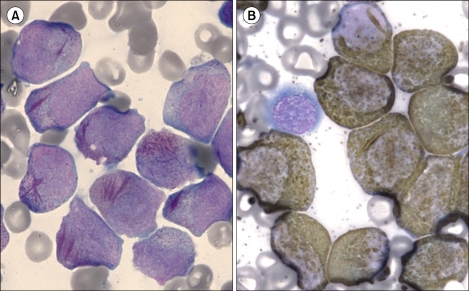Korean J Hematol.
2010 Jun;45(2):133-135. 10.5045/kjh.2010.45.2.133.
A variant acute promyelocytic leukemia with t(11;17) (q23;q12); ZBTB16-RARA showing typical morphology of classical acute promyelocytic leukemia
- Affiliations
-
- 1Department of Laboratory Medicine, College of Medicine, The Catholic University of Korea, Seoul, Korea. hankja@catholic.ac.kr
- 2Division of Hematology, Department of Internal Medicine, College of Medicine, The Catholic University of Korea, Seoul, Korea.
- KMID: 2083547
- DOI: http://doi.org/10.5045/kjh.2010.45.2.133
Abstract
- A subgroup of acute leukemia with morphology resembling acute promyelocytic leukemia (APL) shows variant translocations involving RARA and has a different morphology from that of classical APL. The variant APL with t(11;17)(q23;q12); ZBTB16-RARA subgroup has been reported to have leukemic cells with regular nuclei, many granules, absence of Auer rods, an increased number of Pelgeroid neutrophils, strong myeloperoxidase (MPO) activity, and all-trans-retinoic-acid (ATRA) resistance. Here, we report a case of variant APL with t(11;17)(q23;q12); ZBTB16-RARA showing typical morphological features of classical APL, including numerous Auer rods and faggot cells. The leukemic cells expressed CD13, CD33, CD117, human leukocyte antigen (HLA)-DR, and cytoplasmic-MPO on the immunophenotyping study. The diagnosis was confirmed by cytogenetic and molecular studies. To distinguish variant APL cases from classical APL cases, regardless of whether morphologically the findings are consistent with those of classical APL, combining morphologic, immunophenotypic, cytogenetic, and molecular studies before chemotherapy is very important.
Keyword
MeSH Terms
Figure
Reference
-
1. Stone RM, Mayer RJ. The unique aspects of acute promyelocytic leukemia. J Clin Oncol. 1990; 8:1913–1921. PMID: 2230879.
Article2. Barbui T, Finazzi G, Falanga A. The impact of all-trans-retinoic acid on the coagulopathy of acute promyelocytic leukemia. Blood. 1998; 91:3093–3102. PMID: 9558362.
Article3. Menell JS, Cesarman GM, Jacovina AT, McLaughlin MA, Lev EA, Hajjar KA. Annexin II and bleeding in acute promyelocytic leukemia. N Engl J Med. 1999; 340:994–1004. PMID: 10099141.
Article4. Bennett JM, Catovsky D, Daniel MT, et al. Proposals for the classification of the acute leukaemias. French-American-British (FAB) co-operative group. Br J Haematol. 1976; 33:451–458. PMID: 188440.
Article5. Chen Z, Brand NJ, Chen A, et al. Fusion between a novel Krüppel-like zinc finger gene and the retinoic acid receptor-alpha locus due to a variant t(11;17) translocation associated with acute promyelocytic leukaemia. EMBO J. 1993; 12:1161–1167. PMID: 8384553.
Article6. Corey SJ, Locker J, Oliveri DR, et al. A non-classical translocation involving 17q12 (retinoic acid receptor alpha) in acute promyelocytic leukemia (APML) with atypical features. Leukemia. 1994; 8:1350–1353. PMID: 8057672.7. Hummel JL, Wells RA, Dubé ID, Licht JD, Kamel-Reid S. Deregulation of NPM and PLZF in a variant t(5;17) case of acute promyelocytic leukemia. Oncogene. 1999; 18:633–641. PMID: 9989813.
Article8. Wells RA, Hummel JL, De Koven A, et al. A new variant translocation in acute promyelocytic leukaemia: molecular characterization and clinical correlation. Leukemia. 1996; 10:735–740. PMID: 8618456.9. Licht JD, Chomienne C, Goy A, et al. Clinical and molecular characterization of a rare syndrome of acute promyelocytic leukemia associated with translocation (11;17). Blood. 1995; 85:1083–1094. PMID: 7849296.
Article10. Sainty D, Liso V, Cantù-Rajnoldi A, et al. A new morphologic classification system for acute promyelocytic leukemia distinguishes cases with underlying PLZF/RARA gene rearrangements. group français de cytogénétique hématologique, UK cancer cytogenetics group and BIOMED 1 European coomunity-concerted acion "molecular cytogenetic diagnosis in haematological malignancies. Blood. 2000; 96:1287–1296. PMID: 10942370.11. McKenna RW, Parkin J, Bloomfield CD, Sundberg RD, Brunning RD. Acute promyelocytic leukaemia: a study of 39 cases with identification of a hyperbasophilic microgranular variant. Br J Haematol. 1982; 50:201–214. PMID: 6949609.
Article12. Aventin A, Mateu R, Martino R, Colomer D, Bordes R. A case of cryptic acute promyelocytic leukemia. Leukemia. 1998; 12:1490–1506. PMID: 9737701.
Article13. Neame PB, Soamboonsrup P, Leber B, et al. Morphology of acute promyelocytic leukemia with cytogenetic or molecular evidence for the diagnosis: characterization of additional microgranular variants. Am J Hematol. 1997; 56:131–142. PMID: 9371524.
Article14. Paietta E, Andersen J, Gallagher R, et al. The immunophenotype of acute promyelocytic leukemia (APL): an ECOG study. Leukemia. 1994; 8:1108–1112. PMID: 8035602.
- Full Text Links
- Actions
-
Cited
- CITED
-
- Close
- Share
- Similar articles
-
- ZBTB16-RARalpha variant of acute promyelocytic leukemia with tuberculosis: a case report and review of literature
- Acute Monocytic Leukemia with t(11;17)(q23;q21) Involving a Rearrangement of Mixed Lineage Leukemia Gene
- A Case of Acute Promyelocytic Leukemia with Co-existence of BCR-ABL1 and PML-RARA Rearrangements Detected by PCR
- Molecular methods for genomic analyses of variant PML-RARA or other RARA-related chromosomal translocations in acute promyelocytic leukemia
- Overview of Acute Promyelocytic Leukemia




